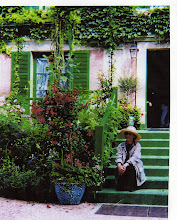Sat down with Laura Simon a while back, Laura has the most beautiful organic vegetable garden I have ever seen. She has such happy combinations of flowers, vines, fruit, vegetables, happy dogs who like to retrieve squash, chickens mulling about - it's idyllic.
I asked her for help in determining seeding times, as she is the most dedicated vegetable gardener that I know here
I don't know how to post links yet, but go to the "farmers almanac" on google and look at their schedules.
in general , later than you think -but preparing the soil early is not a bad thing, especially as we get so busy here starting at least 2 weeks before memorial day.
Laura starts most of her seed indoors, she has set up a great space in what is normallly her guest room. it's upstairs, war, south and west facing windows. She has an oil cloth on the floor, a table set up with more oil cloth to set her trays on, and an upper frame so she can use grow lights if needed. Nice to have it all indoors as these days are still so cold.
many of her seedlings she is able to set out into great cold frames when they have established roots, so there is room for the next round, and so those seedlings begin the" hardening off" process.. acclimating themselves to temperature fluctuations and building stronger systems (see garden terms blog).
I started mine yesterday 3/31 in the walk-in cold frame. I have heat mats attached to a thermostat, placed on insulated material, and at first i use covers on the trays to keep heat and moisture in - the weather is very up and down. Bottom heat is consistent, but air temp fluctuates and could harm new sprouts. On the other hand, leaving he clear lids on the flats too long and various fungal diseases can set in in that nice warm moist place.
These are special mats developed for horticultural use - they are sealed, water cannot enter, do not use a heating pad!
This year I'm also covering the flats at night with some winter blanket I have on hand - I really loathe paying for the electric, so it's a conservation effort on my part.
A neighbor has a shelf by a window over his heating. He adds a regular light bulb to increase light and add some warmth.
Read those packages, go on line, different seed germinates at different temperatures, and with different day lengths. Also note the time of maturity - say 52 days for a squash, what will you be doing in 52 days? Maybe you should wait 2 weeds before you start your seeds.
A note on lettuce - easy to start, bolts when it gets hot, unless you have a customer who wants to buy lettuce from you, grow just as much as you can use in a given time, and plan to replace on a regular basis. Lettuce is very pretty, so think of innovative ways to use it in containers, window boxes & perennial beds.

